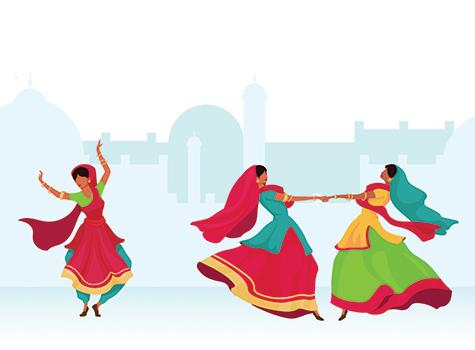By Preethi Sriram

I have seen a good share of Indian movies and there has been content that I thought was amazing. There was content that explored topics of beauty in a film called Mugam, where the main actor Nassar depicts a facially deformed character who must make a choice of being pained for beauty or being pained by an ignorant society and their treatment of him for the way he looks. When noting how the character is “pained” in his portrayal, the character wears a mask that hurts him physically, but the mask allows him to be accepted by society. Parallels can be drawn to what people may go through in society for the pursuit of what they may feel is good looking. For instance, maybe someone wants to go through surgery to get a physical enhancement to feel better about themselves and are willing to take a high risk with their health for something that may be viewed as superficial to others.
Another thought-provoking movie I enjoyed watching was Bombay because it felt like a movie that tried to unite people of different ideologies. Moondram Pirai a film starring Kamala Hassan and Sridevi was an insightful movie where the topic of vulnerability, and how should the most vulnerable in society be treated was explored. And another favorite that I recall is Mudhalvan where the concept of choosing between personal happiness and the welfare of the state is analyzed. These are some of the movies that stick out to me which I thought were captivating due to the topics and themes that were delved into.
I have also danced to many Indian songs during various festivals. Even if I have not seen the movie, there are songs that we had danced to for festivals. Some songs that I recall include “Taal Se Taal” from the movie Taal, “Bhumaro” from the movie Mission Kashmir, and “Nimooda” from the movie Hum Dil De Chuka Sanam. One that is funny and memorable for me is where I had the opportunity to dance for a garba song called “Dholi Taro Dhol Baaje” from the movie Hum Dil De Chuke Sanam, but I kept tripping on stage because of my long lehenga. (It was not funny when it was happening, but I can look back and laugh and feel it was a good lesson).
So, then it may come as ironic, that for a while I have also avoided watching many Indian movies. While I have seen thought provoking content which I would recommend, in general, many of the movies I have simply avoided because of the content. Even while being able to enjoy the music, simultaneously, I did not enjoy certain themes, or representations. I decided that I would stick with other shows on various streaming platforms.
But social media has a sneaky way of piquing interest through simple word of mouth on the social media street. Very recently, along with others, I had heard that the song “Naatu Naatu” from the movie RRR had won an award for best original song from the Golden Globes and the Oscars. Once I found that out, I had to watch the movie. My husband and I both watched the movie together. The movie for the subject matter explored was amazing. For me, it felt a pan-Indian consciousness was being presented, which is a movie that I could relate to within that theme. I could also see that the director incorporated concepts from the Ramayana and Mahabharatha which was captivating to watch. After finishing the movie, “Naatu Naatu” was played in our house for a good amount of time. It became almost its own Suprabhatham throughout the day.
So, from watching the movie RRR directed by RR Rajamouli, it was but natural to try to find other movies by the same director to watch. Thus, we happened upon the epic journey of Bahubaali. The journey was an intense one starting with Baahubaali 1 and then going onto Baahubaali 2. From past experiences, the movie Titanic by James Cameron helped to prepare us for the ride of Bahubaali. In this movie was where one of the songs that became the next Suprabhatham was encountered. This is the song “Dhivara” within the movie.
In the song, my husband later searched for the lyrics and noted that some of the lyrics in the song were in Sanskrit and inspired from a section in the Ramayana. Dhivara, Prasana Shourya Bhara. This of course piqued my interest because I read the Ramayana when in eighth grade. The book was presented to me by my great uncle and aunt along with the Mahabharatha. Both versions were a version by C Rajagolachari. Having read these two books I have been very influenced by the various topics within the epics as it seems to be content that one can think about at different stages in life.
As an adult, learning that the song had influences from the Ramayana, I was thus inspired to seek out the version of the Ramayana that has these scenes. I found a version of the Valmiki Ramayana to listen to. In this version, which is a translation, Hanuman is encountered as a general in the Vanara Kingdom to Sugreeva. In one of the scenes, the group of Vanara monkeys are trying to decide who can make it Lanka to find Seetha. Some noted what they could do, but all noted that they could not make it the full distance to Lanka and back. It is noticed by Jambavant, who is a bear hat Hanuman is quiet. He then tells Hanuman that he knows him to have tremendous ability and then goes on to discuss Hanuman’s birth and power. He notes that Hanuman was begotten by Vayu, the wind God, and soon after his birth, he leapt thousands of miles wanting to catch the sun and was struck down by Indra. Vayu, Hanuman’s father was grieved that Hanuman was killed, and stopped blowing and then all beings began to suffocate. The Gods, to appease Vayu, brought Hanuman back to life and blessed Hanuman with many powers. With these blessings, Hanuman became fearless as a young child and was mischievous and causing havoc, and to check him, the Rishis made an implication that Hanuman would forget his powers until it was heard from another.
Jambavant finishes his narration to Hanuman and mentions there is no doubt that he would be able to jump to Lanka, and asks why he is sitting there quietly, seeing the other monkeys in despair. At this, Hanuman rises, and remembers his great powers and with a great roar, declares that he will jump across the mighty ocean and expands his body from his normal height and announces his descent from Vayu and says that he can leap to the outer limits of the universe and can overtake the blazing sun and proclaims that he will easily reach Lanka. With that, Hanuman roars again and again to the delight of the other assembled beings.
This is such a powerful scene. I continue to think of this scene and the way Hanuman has awakened to himself. He is reminded of his potential. This is the scene that now has caused me to buy the Sanskrit Version of the Valmiki Ramayana with English translations to further learn about this scene. Can this scene of Hanuman and his awakening have themes as well that people can learn from? Does this story of Hanuman have a lesson for us everyday people? That is something to ponder on as many scenes in the Ramayana are scenes to ponder upon.
Imagine in our daily lives, we think that we are mundane. Or we want to do something, but do not have confidence in ourselves. But then, alas, a friend, a family, a teacher, a guru, a poet, a writer, a song: They remind us to stand up and see who we are and our origins. From a scientific point of view, some say we are products of the Big Bang: that we are all made from the stars. It took many billions of years to be who we are today.
Inspiration can be in places when we are looking, or sometimes, we happen to come upon it when we are least looking. This was found by happenstance within a song from the movie Baahubali.
Dhivara, Prasara Shourya Bhara: Uthsara Steera Gambheera. Ugrama Aasama Shourya Bhaava. Roudrama Navaa Bheethirma.
Or as Mufasa, the father in The Lion King tells his son Simba, “Remember who you are.”
This series of articles is about the journey and unique insights of an adult dance student learning classical Indian dance and the experiences and perspective of taking classical Indian dance as both an American and an Indian.
Preethi Sriram is a classical Indian dance enthusiast and lifelong learner of dance. Contact: [email protected]



